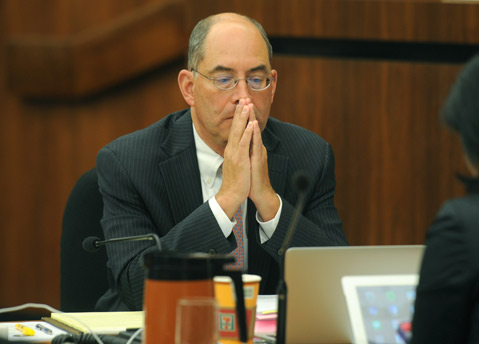P-ing Up a Rope?
County Looks to Soften Legal Blow from Fracking Ban

“Yes, comma.” Such was the answer from County Counsel Mike Ghizzoni on Tuesday when asked whether Measure P has — and would continue to, if voters enact the fracking ban on November 4 — put his office in a vise. But, added Ghizzoni — under the spotlight of supervisors and public commenters at the board meeting — the rules that county staff will hammer out in preparation of the initiative’s potential passage could at least minimize the number of lawsuits expected from landowners and oil companies.
In its quest to ban all new fracking, acidizing, and cyclic-steaming operations in the county’s unincorporated areas, the measure has already attracted two legal threats against the county, one from PetroRock LLC and one from ERG Operating Company, both of which run cyclic-steaming wells outside of Santa Maria.
As was suggested in Measure P’s own language, the Board of Supervisors voted unanimously in Tuesday’s special meeting to have county planners examine all of the possible legal attacks the measure could foment — vested rights, property takings, and violations of the state and/or federal constitutions — and establish the protocols for dealing with them and protecting itself in the process.

The recently formed, industry-backed “No on P” crowd turned out in full force and went comment-to-comment with the blue-shirt-wearing and Measure P–spearheading Water Guardians. (A few politicos also attended the show, including former Sheriff’s candidate Sergeant Sandra Brown, now in charge of bailiffs; former congressional hopeful Justin Fareed; and Ron DeBlauw, who is challenging Assemblymember Das Williams — a Measure P spokesperson — for his seat.)
Where one pro-P speaker likened the purported omnipresence of legal threats to the false promises made in Nigerian email scams, Ghizzoni backed up industry representatives’ assertions that lawsuits are likely. “We are certainly planning for some amount of litigation. We don’t have a history on something like this to predict whether that’s 10 cases, 100 cases, or how much litigation we would expect,” Ghizzoni said, adding that the county doesn’t have insurance coverage to handle takings claims.
Ghizzoni — peppered with questions from Supervisors Peter Adam and Steve Lavagnino over the measure’s reaches and those reaches’ effects on the county — said his office was already slammed just in readying for the measure and, if the initiative passes, would likely need two new full-time attorneys to handle Measure P–related claims, not to mention possible lawsuits from environmental groups that could allege that the exemptions go too far.
While the measure’s supporters stuck to their argument that Measure P won’t harm already-permitted projects, oil reps stuck to their counter-argument that it will. Without the county’s protocols in place, Ghizzoni said, existing operations see a “pretty big overlap” with vested rights, which, along with how to treat well-maintenance techniques, could present the biggest pickle. Supervisor Janet Wolf suggested that staff look at including an exemption for maintenance treatments in its protocols; according to Kevin Drude, in charge of the county’s Energy Division, every well “at some point in its lifetime” will require such maintenance, either for minor stimulation or de-gunking.
Rachel Hooper, the lawyer for the San Francisco–based firm that wrote Measure P as well as a similar ballot initiative going before San Benito County voters in November, wrote in a letter to Ghizzoni that the measure’s backers support the county’s efforts to “codify the processes for applying these exemptions” as doing so would make for a “smooth transition period” in the weeks between the initiative’s passage and its implementation. Notable Water Guardians Katie Davis and Rebecca Claassen urged the supervisors, respectively, to not be swayed by the “scare tactics” waged by the oil industry and to remember that Santa Barbara County is “far from alone” in trying to ban such drilling operations.
On the national level, the federal Government Accountability Office on Monday chastised the Environmental Protection Agency for its lax oversight of water- and earthquake-related risks tied to fracking. The controversial practice hasn’t been on Santa Barbara County’s radar since the supervisors put in place tough regulations in 2011. However, according to Drude, more than half of the county’s 1,200 active oil wells use cyclic steaming, and most of the project proposals on his desk want to use cyclic steaming, too.



